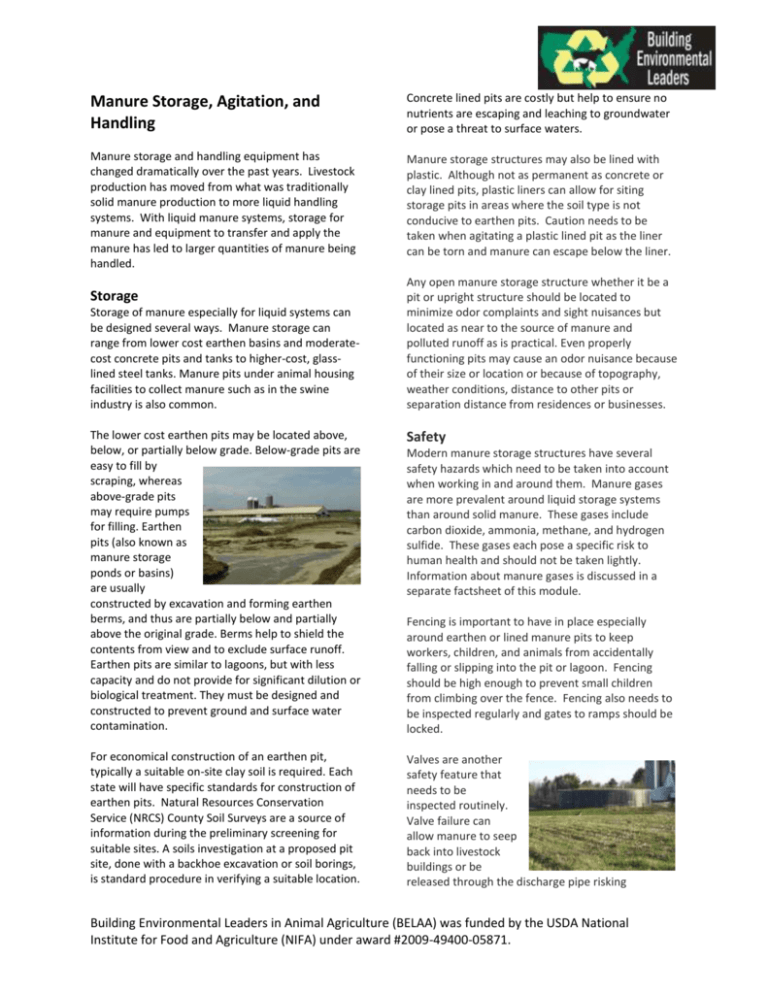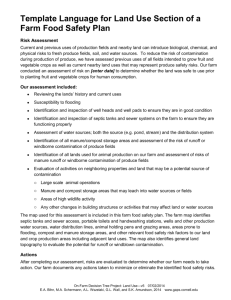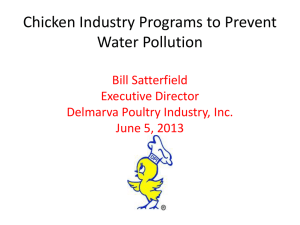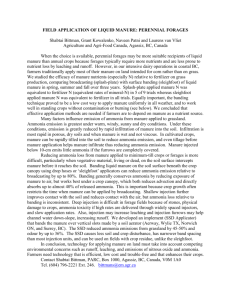Manure Storage, Agitation, and Handling
advertisement

Manure Storage, Agitation, and Handling Concrete lined pits are costly but help to ensure no nutrients are escaping and leaching to groundwater or pose a threat to surface waters. Manure storage and handling equipment has changed dramatically over the past years. Livestock production has moved from what was traditionally solid manure production to more liquid handling systems. With liquid manure systems, storage for manure and equipment to transfer and apply the manure has led to larger quantities of manure being handled. Manure storage structures may also be lined with plastic. Although not as permanent as concrete or clay lined pits, plastic liners can allow for siting storage pits in areas where the soil type is not conducive to earthen pits. Caution needs to be taken when agitating a plastic lined pit as the liner can be torn and manure can escape below the liner. Storage Storage of manure especially for liquid systems can be designed several ways. Manure storage can range from lower cost earthen basins and moderatecost concrete pits and tanks to higher-cost, glasslined steel tanks. Manure pits under animal housing facilities to collect manure such as in the swine industry is also common. Any open manure storage structure whether it be a pit or upright structure should be located to minimize odor complaints and sight nuisances but located as near to the source of manure and polluted runoff as is practical. Even properly functioning pits may cause an odor nuisance because of their size or location or because of topography, weather conditions, distance to other pits or separation distance from residences or businesses. The lower cost earthen pits may be located above, below, or partially below grade. Below-grade pits are easy to fill by scraping, whereas above-grade pits may require pumps for filling. Earthen pits (also known as manure storage ponds or basins) are usually constructed by excavation and forming earthen berms, and thus are partially below and partially above the original grade. Berms help to shield the contents from view and to exclude surface runoff. Earthen pits are similar to lagoons, but with less capacity and do not provide for significant dilution or biological treatment. They must be designed and constructed to prevent ground and surface water contamination. Safety For economical construction of an earthen pit, typically a suitable on-site clay soil is required. Each state will have specific standards for construction of earthen pits. Natural Resources Conservation Service (NRCS) County Soil Surveys are a source of information during the preliminary screening for suitable sites. A soils investigation at a proposed pit site, done with a backhoe excavation or soil borings, is standard procedure in verifying a suitable location. Valves are another safety feature that needs to be inspected routinely. Valve failure can allow manure to seep back into livestock buildings or be released through the discharge pipe risking Modern manure storage structures have several safety hazards which need to be taken into account when working in and around them. Manure gases are more prevalent around liquid storage systems than around solid manure. These gases include carbon dioxide, ammonia, methane, and hydrogen sulfide. These gases each pose a specific risk to human health and should not be taken lightly. Information about manure gases is discussed in a separate factsheet of this module. Fencing is important to have in place especially around earthen or lined manure pits to keep workers, children, and animals from accidentally falling or slipping into the pit or lagoon. Fencing should be high enough to prevent small children from climbing over the fence. Fencing also needs to be inspected regularly and gates to ramps should be locked. Building Environmental Leaders in Animal Agriculture (BELAA) was funded by the USDA National Institute for Food and Agriculture (NIFA) under award #2009-49400-05871. environmental and property damage or livestock losses. Overtopping of manure is also a risk of manure storage structures. Most manure management plans or permits call for at least 12 inches of freeboard or free space from the surface of the manure to the top of the storage structure. Agitation Handling and application of manure has changed greatly over the past few years. With more livestock facilities creating liquid manure and using storage facilities, traditional box spreaders are being replaced by tankers and dragline or hose application systems. In order for the manure to be pumped and applied through these systems, the storage facility needs to be properly agitated. If bedding and fibrous material is used for livestock comfort, it will break down very slowly, or not at all, in a pit or upright structure. Non-degradable material leads to sludge buildup or the formation of crusts on the surface, both of which require vigorous agitation for removal from the pit during pumping operations. Agitation before and during the manure removal phase or pump-down is necessary to ensure that solids in sludge or crusts are removed. Otherwise, the effective volume of the pit will be severely reduced in a short period of time. Agitation is accomplished by using high-horsepower, propeller-type agitators or by recirculation with high-capacity pumps. It is recommended that manure be agitated for at least thirty-minutes prior to pumping. Agitation should continue throughout the pumping process or until the manure in the structure is adequately mixed. Manure should be tested periodically throughout the pumping and application process to determine if changes in nutrient content are occurring as the structure is emptied. Even with the best agitation practices, not all nondegradable material can be removed. An example of this would be sand used for cow comfort in the dairy industry. Sand typically settles to the bottom of a manure storage structure and can be difficult to remove by agitation and pumping. Use of dredges, backhoes, or pay loaders may be needed to remove all sand from the storage structure. If other equipment is needed in the pit, it is recommended to test for manure gases before using equipment in the pit. Access Ramps and Platforms All manure storage structures need to be correctly designed to provide access of manure handling equipment. For earthen or lined manure pits, concrete access ramps and pumping/agitation platforms should be provided as needed for allweather access to the storage structure for agitating, pumping or mechanically removing solids. Ramps should be accessible on several sides of the pit to provide for proper agitation. Ramp slopes should be no steeper than 10:1 for tanker/spreader access and no steeper than 5:1 for tractor/agitator or tractor/pump access. Grooves or ridges 1 inch or more deep across the ramp should be formed into the concrete before it sets to improve traction. Concrete platforms built into the inside slope of earthen pit berms greatly facilitate positioning of pumping and agitating equipment For upright storage structures, a solid loading area should be built of concrete or other impervious material to allow for tankers or other handling equipment easy access to discharge pipes. Manure Level Indicators Pump-down or manure level markers, or indicators, are a simple but important component of a manure storage facility. Such a marker enables the operator to ascertain quickly and easily the degree of fill of the manure storage facility, the point at which pumping or emptying should begin, and the point at which it should end. The presence of a durable, easily read marker gives inspection or regulatory personnel confidence that a manure storage facility is being managed properly. Source: Earthen Pits (Basins) for Liquid Livestock Manure, University of Missouri-Extension, publication EQ388







